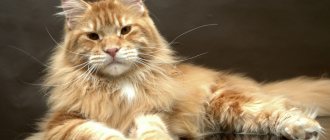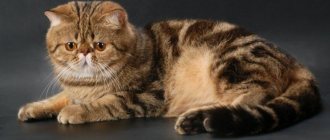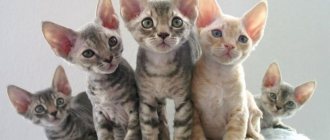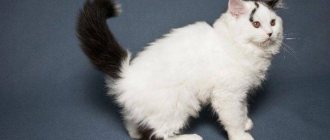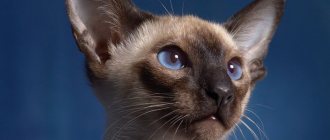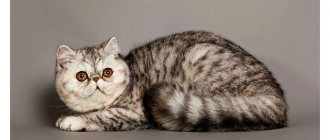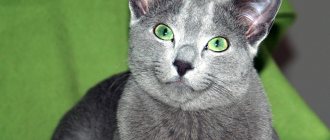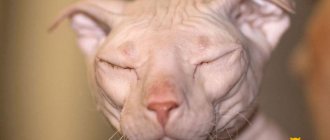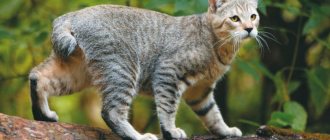Cat breeds with big ears have a wild appearance that reflects their origins in big cats, and this unique trait is making domestic cats with big ears more popular than ever. In the wild, these huge ears serve an important function, allowing the cat to hear even the smallest sounds while hunting for prey.
There are many aspects to cats that make them adorable pets: their soft fur, long tail, and of course, their all-knowing eyes. But perhaps at the top of the list are their ears, and the bigger they are, the cuter they are. We've compiled this list of 12 cat breeds with big ears so you can see them in all their adorable glory!
Siamese cat
© shutterstock
The Siamese cat is one of the most recognizable Asian cat breeds and one of several breeds found in Thailand. They are long, slender and elegant cats with sleek coats that are usually a mixture of chocolate, cream and black. The Siamese cat is smart and very affectionate with its owner. With such long and slender legs, body and tail, it is no wonder that the ears appear even larger than they really are!
Types of wild cats with large ears
The record holder for the largest ear size among the cat species living in the wild is the African Serval.
Serval
This is a medium-sized cat, up to 65 cm high at the withers and up to 1.5 m long from the nose to the tip of the short tail. Bright, almost orange in color (the intensity of the main tone depends on the subspecies) with black spots, white belly, quills and false “eyes” on the back of the ears. The predator's ears are truly outstanding in size, more than 5 cm, set high and vertical. Due to the high and slender paws and small head with a long and muscular body, it gives the impression of a very graceful creature. Although he is more of an athlete. Lives mostly in Africa.
Recently, it has become fashionable and status-bearing to keep an exotic cat in the house. To do this, the kittens are taken away from the breeding female early and hand-fed. The domestic Serval is a unique and wonderful, very beautiful pet. But few can afford to own such a cat - the price of an animal starts from half a million rubles. Keeping and caring for a pet is also not cheap.
Another wild beauty is Caracal. This is a separate species of cat, common in Asia, Dagestan, and China. Sometimes it is called the steppe lynx, but this is morphologically incorrect; it is more close to pumas.
Caracal
Slightly lower than the Serval, but more powerful and wider. The coat ranges from pale red to bright cherry color, and the eyes are often bright blue, surrounded by a black rim. The abdomen, quills and false “eyes” on the ears are white. The ears are very large with high black tufts. Just like the Serval, it is expensive to purchase and maintain.
Another big-eared cat predator is the much smaller Sandy or Dune cat. This savage is even smaller than a pet. Body length up to 90 cm, half of which is on the tail. The maximum weight of a male is 3.5 kg.
Dune cats
The coat is thick, soft, sandy, sometimes gray. The head is large, flattened, with thick sideburns. The ears on such a small animal seem simply huge - they are located widely and extend onto the side of the skull. They are reminiscent of such “locators” and the piercing gaze of the green eyes of space aliens. It lives in the Sahara, the Arabian Peninsula and Central Asia. This desert animal has an absolutely wild disposition and is absolutely not suitable for domestication.
An animal that very little is known about is the Chinese or Gobi desert cat. This species is endemic to China.
Gobi desert cat
Thick reddish skin with sparse stripes and thick soft hair visually increases the size of this small animal. The maximum weight of males is about 9 kg. The length with the tail is a little more than 90 cm, the height at the withers is 30. The ears of this steppe inhabitant are very large with expressive tassels reminiscent of lynxes.
These amazing creatures have been exterminated for a long time and intensively, today their population is less than ten thousand heads. They are listed in the second appendix of CITES - the convention on international trade. They are protected today by the Republic of China. Not social animals, there was no case of domestication.
The amazing animal Margay or Long-tailed cat lives in the tropical forests of South America. A bright, beautiful, medium-sized (up to 8 kg) representative of the leopard coloring, extremely rare and protected by the international community. The animal's ears are large, widely spaced, the tips almost do not narrow and are smoothly rounded.
Margay
Sphinx
© shutterstock
The Sphynx breed is most widely known for its fur—or shall we say, lack thereof! Hairless cats usually have large ears, and the Sphynx is no different. Lack of hair in cats is usually the result of a natural genetic mutation, but Sphynx cats have been selectively bred to be hairless. These cats are highly sought after, which is why they are rare and expensive, and their large ears make them a unique and attractive cat breed.
Elf
A cat with such a name simply cannot have a familiar appearance. This strange breed is the result of crossing a Sphynx and an American Curl. Hairless, heavily wrinkled cats with large curved ears resemble characters from science fiction films. This is a cross between Dobby from the Harry Potter series and Master Yoda from Star Wars.
We must pay tribute to the owners of these unusual pets. They have to make sure that the cats do not get cold in the draft and do not burn in the heat. In addition, constantly sweating, sticky elves require regular skin care. And going out into the world with such pets is already a small feat.
What is the price
In Russia – 20,000 – 50,000 rubles; in Ukraine – 5,000 – 21,000 UAH.
Author's comment
If you want a pet that resembles an alien mummy, get an elf cat.
Cornish Rex
© shutterstock
The Cornish Rex, a breed of domestic cat often called a "greyhound", has a unique coat among cat breeds. Their fur is short, soft and silky, forms waves along the body and consists almost exclusively of undercoat. This soft, curly coat is prone to shedding, and these cats eventually lose most, if not all, of their fur.
Health
The health of the Javanese cat is vulnerable and requires constant attention. Diseases include heart disease, asthma, neurosis, strabismus, and digestive problems. Some individuals inherit diseases. Be sure to take your pet to an appointment with a veterinarian: he will determine the necessary vaccinations and the timing of their administration; regular visits will help maintain the pet’s health throughout its life.
If you notice that the cat’s usual activity has decreased, the cat has begun to eat poorly, avoids its usual company, discharge has appeared from the eyes, ears, mouth, and digestion has been disturbed - do not self-medicate, contact the veterinarian unscheduled and as early as possible.
Devon Rex
© shutterstock
The Curly Cornish Rex's cousin, the Devon Rex, is similar in appearance, but their coat is caused by a different genetic mutation, making them a completely different breed. They are often called "alien" cats due to their unique appearance, which is highlighted by their huge, rounded ears that sit uniquely low on their heads. Another unique feature is their whiskers, which are so short and curled that they often appear to have none.
Breed care
The animal's thick hair is prone to tangles, so Manx cats need to be combed 1-2 times every 7 days. The owner should have a brush, a furminator and combs at his disposal.
A cat gives birth to 3-4 kittens; if their number is greater, one of them may die due to intoxication. A gene that carries signs of a short tail often leads to pathology in a kitten in the form of a violation of the structure of the spine and further damage to the spinal cord. This manifests itself in constipation, difficulty urinating and hernias. It happens that Manx syndrome, namely ossification of the caudal vertebrae, manifests itself even in long-tailed animals. Therefore, kittens have their tails removed immediately after birth to avoid such diseases.
It is contraindicated for an animal to fall, as the consequences may be severe. You need to make sure that the cat does not climb too high.
Eastern cat
© shutterstock
Both shorthaired and longhaired Oriental cats have characteristically long ears and are closely related to Siamese cats. They are social, playful and often vocal cats, characteristics they share with their Siamese cousins. The main difference is their coat, which can come in a variety of colors and patterns. Their genetic roots are in Thailand, and since then the breed has become one of the most popular among members of the Cat Fanciers' Association.
Nutrition
The main place in caring for a Javanese cat should be given to the selection of diet. Feed your cat balanced dry food and premium canned food (pedigree cats have sensitive digestion).
The food should be fractional, calculate the norm based on the cat’s weight - up to 50 grams per kilogram of weight, food - at room temperature. Give vitamin-mineral supplements and always leave clean water in the bowl. If you decide to introduce natural products into your diet, opt for meat (except pork) and poultry. Fish is allowed in small quantities, only sea fish and boiled without salt.
Buy Javanese kittens from specialized nurseries or from professional breeders, so you will receive a pure individual that fully meets the standards. The cost of a Javanese cat is higher than that of a cat. Purely expressed pets, whose parameters correspond to the exhibition ones, are estimated from one hundred thousand rubles. Javanese with defects is much cheaper, but, of course, it is not suitable for breeding offspring.
Balinese cat
© shutterstock
With their sapphire blue eyes and distinctive dotted coloration, Balinese have much in common with their close relatives, the Siamese. Indeed, the Balinese are widely known as purebred longhaired Siamese, as they originated as a natural mutation of the breed, with the only real differences being their longer coat and bushy tail.
They were originally known as Longhaired Siamese cats, but the original breeders felt that this was too verbose and subsequently shortened the name to Balinese.
Bambino
The Minskin and Bambino breeds are an example of how crossing two identical breeds can produce different results. A sphinx and a munchkin participated in the creation of the designer hybrid. The results were different, but equally terrible. Nude body, oily wrinkled skin, tiny legs.
Strange pets require careful care. Their body must be constantly wiped with a damp sponge to avoid finding greasy stains on furniture upholstery and clothing. Pets do not tolerate heat and cold well, they need to be protected from direct sunlight. Until old age, bambinos remain agile, curious kittens. They are playful and want to be aware of all everyday problems.
What is the price
In Russian nurseries - 25,000 - 100,000 rubles; in Ukrainian – 10,000 – 70,000 UAH.
Author's comment
In some countries, breeding cats of this experimental breed is prohibited.
Abyssinian cat
© shutterstock
These large-eared, short-haired cats were believed to have been first bred in Abyssinia, where they got their name. Their unique coat is known as a "ticked" tabby coat, in which individual hairs are colored differently. Their large ears also have unique tufts that emerge from pointed tips. They are active, playful and very affectionate felines who are known to sing with a unique birdlike trill.
Rare and non-standard cat breeds
Less common cats with large ears include:
- poodle cat;
- Havana;
- toyger
Poodle cat
These curly cats with large ears appeared quite recently and have not yet become popular. Their curly coat makes them resemble a poodle. Representatives of the breed are not only straight-eared, but also lop-eared. These unusual cats have a friendly and easy-going disposition.
Long-eared poodle cats easily adapt to any conditions and tolerate loneliness well.
Havana
The breed, called Havana Brown, was developed in the UK by crossing a Siamese and a domestic black cat. Despite the fact that Havana was registered in the middle of the last century, it was not widely used.
These elegant short-haired cats with large ears and a long muzzle are easily recognized by their unusual ellipse-shaped head and shiny dark brown coat.
Toyger
These long-eared cats with a long muzzle were bred in America in 1993. Outwardly, they resemble miniature tigers. The toyger's long body is covered with short, spotted fur. And a “domestic tiger” weighs only 7-9 kg.
Spotted cats with large ears are endowed with a calm and friendly disposition. Toygers quickly become attached to their owners and easily adapt to apartment living.
Ocicat
© shutterstock
The Ocicat is a domestic breed that has the mentality of a wild cat. However, he has no recent wild DNA, and while his spotted coat certainly gives him the appearance of a wild animal, his calm and docile temperament betrays his domestic nature within minutes. It gets its name from its resemblance to the ocelot, a small wild cat native to the Americas.
Cymric
According to legend, Cymric cats lost their tails when they jumped into Noah's Ark at the last minute. The absence of a tail, partial or complete, is the main distinguishing feature of the breed. But this is not the only reason why the Cymrik made it into our TOP “The most terrible cat breeds”. The animals have a strong, stocky body, powerful hind legs that are longer than the front legs.
Kymriks are hunter cats. They are very inquisitive, agile and can climb to the highest places in the house. This causes discomfort to cat owners; they complain that cats take things from the highest shelves.
What is the price
There are no nurseries of this breed in Russia and Ukraine. In the USA, such kittens are sold at prices ranging from $350 to $1,500.
Author's comment
If your dream is a stocky, powerful cat that looks like a sumo wrestler constantly, the Cymrik will be the perfect choice!
Savannah Cat
© shutterstock
The Savannah is a cross between a domestic cat and a medium-sized long-eared African cat called a serval. This uniquely beautiful breed was first registered by the International Cat Association in 2001 and is becoming increasingly popular.
Despite their wild origins, they are friendly, sociable animals known for their loyalty, often following their owners around the house. These highly intelligent cats are known to open doors and cupboards on their own, so be careful when hiding their food!
Maine Coons
The origin of this cat is surrounded by myths: they claim that the breed was obtained by crossing a cat and a lynx. But that's not true. Initially, the breed was very common in Maine. Severe snowy winters have led to the appearance of cats with thick, long hair, large paws and tufted ears.
The Maine Coon breed gets along well with people, but is not overly tame. They are moderately sociable, calm, and in their youth they prefer to climb trees. Coons inherited a passion for hunting from their ancestors, and kittens of this breed love to play with balls and toy mice.\
Singapura cat
© shutterstock
The smallest breed of domestic cat, these small felines are known for both their huge ears and large eyes. They have a beautiful ticked coat that usually comes in several variations of brown, and they rarely reach a weight of more than 4 kg. They are active, playful and curious and love to be up high to get a bird's eye view of their home. There is controversy surrounding their true heritage, but most breeders agree that the cat is originally from Singapore, where they got their name.
Ukrainian Levkoy
The rating of cats a la Frankenstein continues with another hairless cat. This experimental breed combines the incongruous: the floppy ears of the Scottish Fold and the hairless body of the Don Sphynx. Surprisingly, the work to create a cat with such an appearance was deliberate. This feline Frankenstein is not an accidental mistake of nature, but the work of human hands.
“Terrible on the face, kind on the inside” - this is about the Levkoy. They are active, loving, and constantly crave human attention. You won’t have time to sit down in your favorite chair, and your cat will already be curled up on your lap.
Price
In Russian nurseries - from 10,000 to 25,000 rubles; in Ukrainian – 2,500 – 5,500 UAH.
Author's comment
Fans of “bald folds” need to save their pets from the cold in winter and from open sunlight in summer.
It will be interesting: the top 15 popular cat breeds.
Chausie
© shutterstock
This domestic cat breed certainly has a wild look, which is further enhanced by their large ears, and they were actually created by crossing several species of wild jungle cats with domestic varieties. The kittens are very similar to lion cubs with their deep chests and large, round ears set high. They are intelligent, active and playful cats that remain curious about their surroundings throughout their lives.
Why does a cat have big ears?
In fact, all cats have large ears, it’s just that in some they stand out very much, while in others, upon visual inspection, it seems that the ears and bodies are quite proportional. But if you carefully examine the body of representatives of any breed, it basically turns out that the ears are fully consistent with the rest of the body.
If we consider cats of various breeds, we can highlight the record holder, who is endowed with large ears - the African Serval, but he is far from being a pet. If we consider among domesticated predators, then the largest ears are those of cats of oriental breeds. But the pets that belong to the Persian group have the smallest ears.
Why do cats need large ears? All members of the cat family, regardless of the size of their hearing organs, have the same functions. They also hear and acutely sense everything that happens around them. Probably few people know that these animals can also sense and control everything in a dormant state.
They can easily hear high-pitched, almost ultrasonic sounds from more than 500 meters away. At the same time, they will not be able to overcome various obstacles - wall partitions, crossbars, slabs.
Interesting! Many have noticed that when a cat hears a suspicious sound, it becomes alert, begins to move and turn its ears in different directions. Numerous receptors located on the auditory organs respond to various subtle rustles.
But there is one parameter that still distinguishes cats with large ears from representatives with small hearing organs. Large-eared animals have a pronounced heat transfer function, namely the ability to cool themselves. It is for this reason that it is not for nothing that animal breeds that live in hot countries have large ears.
On the surface of the auricle there is a thin skin, under which there are a large number of veins and blood vessels. Due to the presence of blood vessels, the cooling process occurs when temperatures fluctuate. The higher the temperature, the faster the blood circulates, which means the largest amount will pass through the ear capillaries and cool.
Egyptian Mau
© shutterstock
The Egyptian Mau is one of the few domestic cat breeds with natural spots. They are medium in size, with medium length coats with a beautiful pattern. These cats are a rare breed, with fewer than 200 kittens registered each year. They have a distinctive "scarab beetle" or "M" marking on their forehead, usually characteristic green eyes, and of course, large, pointed ears. These cats are especially sensitive to anesthesia and medications.
Posted by Christian Adams An American expat living in Metro Manila, Philippines for over a decade, Christian is a lifelong cat lover and the proud father of two rescue cats, Trixie and Chloe. Both girls used to be among the crowds of homeless people who roam the cities and countryside. Three-year-old Trixie was rescued from a litter found under a neighbor's porch, and two-year-old Chloe was brought home by Christian's young son, Henry, who discovered the crying kitten in the parking lot.
Characteristics
Let's return to studying the Javanese cat breed in more detail.
So, we have already partially described the appearance of the Javanese cat. In addition to the elongated head, large eyes and ears, the Javanese has an elongated body, the size of which exceeds the body of the Siamese ancestor. The weight of the cat, accordingly, is also greater, sometimes reaching six kilograms. A graceful gait and long legs distinguish the breed from its distant relatives.
The Javanese cat has a beautiful, smooth coat, and the length of the hairs is noticeably longer on such parts of the body as the shoulders, neck, and tail. A distinctive feature of Javanese wool is its hypoallergenicity - it can be kept by owners with intolerance to animal hair. Although, we do not recommend taking risks, allergens are different for each person, it is worth checking compatibility before purchasing a pet for your house or apartment).
Carthusian (chartreuse)
The Carthusian cat is considered the most polite among its relatives. She does not like to complain and shows friendliness not only towards the owner, but also towards any guest who comes to the house.
Chartreuse are the owners of round eyes in a shade reminiscent of a cross between copper and gold. This color looks beautiful against the background of a gray-blue “fur coat”.
Representatives of this rare breed are suitable for busy people: the animals are not too playful and know how to keep themselves busy.
